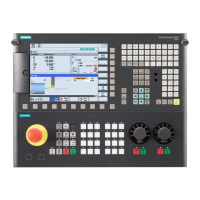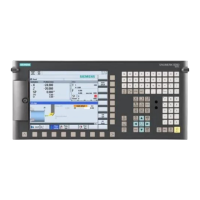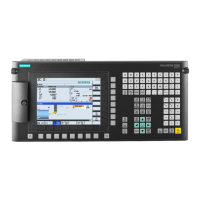Configuring the HMI system
2.1 Processing INI files
HMI Advanced (IM4)
30 Commissioning Manual, 03/2009, 6FC5397-0DP10-3BA0
A skeleton application can define up to 16 horizontal and 8 vertical softkeys. When you leave
an operating area that was selected from a skeleton application, you return to the higher-
level menu of the skeleton application.
The following standard applications can be selected from a skeleton application:
● Machine
● Parameters
● Services
● Program
● Simulation → HMI settings
● Diagnostics
● Commissioning
● OEM application(s)
From the skeleton application, a particular function of an operating area that is accessible
from it can be selected specifically. (e.g. Program → Simulation, all standard possibilities are
specified in the table below). A skeleton application can provide its own main screen as a
bitmap file or display a standard image.
Configuration principle
New operating levels are created by skeleton applications and attached to existing operating
levels. The assignment of horizontal and vertical softkey bars to skeleton applications can be
configured.
Configuration files
Configuration is carried out in the following files:
REGIE.INI Calls the skeleton application(s), standard applications
In REGIE.INI an interpreter task mntmmc is specified as a task in
which the CmdLine:="SectionName1" parameter indicates the section
in which additional information about the inserted skeleton application
in the TASKCONF.INI file is located.
TASKCONF.INI Description of softkeys and the operating areas and background
screen/texts they call, texts for the softkey labeling, if required.
The specifications are made under the section that was specified in the
CmdLine attribute.
RE_xx.INI Softkey labeling of the skeleton application for the language with the
code XX.
